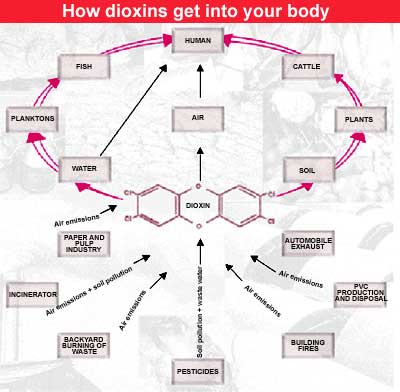Behind the scene
 Dioxins are among the deadliest chemicals known to humans. These chemicals are by-products of industrial processes. They dissolve readily in oils, fats and non-polar solvents. These chemicals are not volatile and are extremely persistent. Since dioxins are fat-soluble, they bioaccumulate up the food chain. dioxin compounds are transported through the atmosphere as vapours or attached to air borne particulates and can be deposited on soils, plants or other surfaces. They enter water bodies by direct deposition from the atmosphere or by surface runoff and erosion. From soils, these compounds can reenter the atmosphere either as resuspended soil particles or as vapours. In water, they can be resuspended into it from sediments or become buried in deeper sediments.
Dioxins are among the deadliest chemicals known to humans. These chemicals are by-products of industrial processes. They dissolve readily in oils, fats and non-polar solvents. These chemicals are not volatile and are extremely persistent. Since dioxins are fat-soluble, they bioaccumulate up the food chain. dioxin compounds are transported through the atmosphere as vapours or attached to air borne particulates and can be deposited on soils, plants or other surfaces. They enter water bodies by direct deposition from the atmosphere or by surface runoff and erosion. From soils, these compounds can reenter the atmosphere either as resuspended soil particles or as vapours. In water, they can be resuspended into it from sediments or become buried in deeper sediments.
Dioxins are released mostly from burning of chlorinated compounds e.g, from garbage, medical waste and toxic chemicals.Dioxins from incinerators contaminate the air, water and food passing these deadly pollutants on to people through milk, meat and other fatty animal products. Bleaching of paper with chlorinated compounds, production of pvc plastics, chlorinated pesticides and secondary smeltering of copper also produce dioxins. Essentially, to produce dioxin we need organic matter, chlorine and a reactive thermal environment.
Despite knowing their carcinogenic nature, there is no monitoring of these chemicals in most countries. And where they are monitored, the dioxin politics is extremely intense. In the us , awareness about dioxins has generated much debate. Just when the Hanoi meeting was underway, the us was awaiting the us Environmental Protection Agency's ( epa s) Science Advisory Board's ( sab s) final report on the decade-long study evaluating the potential dangers dioxins pose to humans. But the long-overdue report never came. The report has been mired in controversy since 1980 when the epa prepared its first draft which revealed that dioxins pose a threat to human health. The report also pointed to chemical multinational Dow Chemical as a major source of dioxins. However, when the report was published by epa headquarters, all references to public health and Dow Chemical were deleted and many epa scientists were forced to resign.
In 1984, epa released its first official risk estimate for dioxins showing them to be the most potent synthetic carcinogen ever tested. And as a reaction in 1991, the chlor-alkali industry-group backed organisation, Chlorine Institute, sponsored the infamous Banbury conference in which independent scientists were not invited. The Institute paid consultant George Carlo, an epidemiologist, to bring out a feel-good report on dioxins ,who made an announcement to the Press that "there has been a
